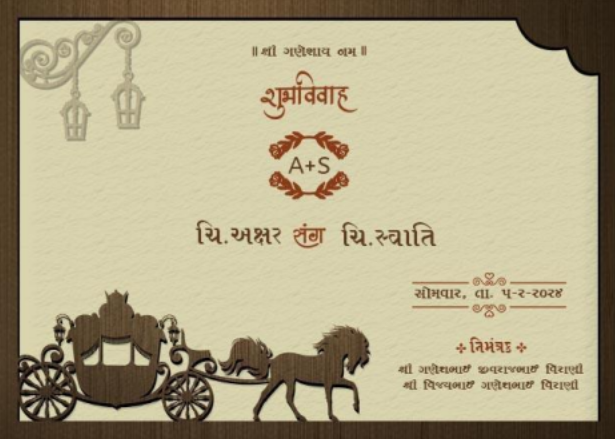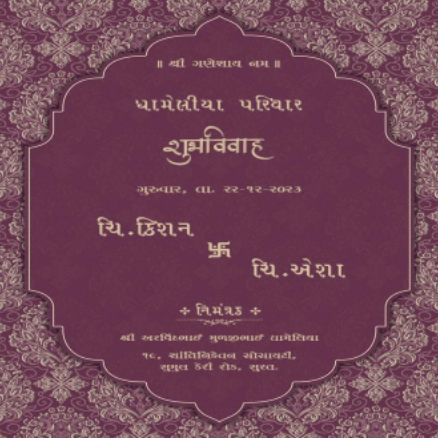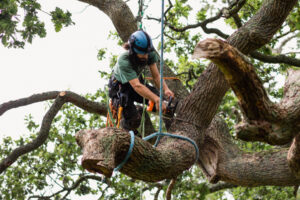
Introduction:
Creating a kankotri tahuko in Gujarati involves carefully blending tradition with modern wedding planning to ensure every aspect of the celebration reflects the cultural richness of Gujarati customs. This guide will help you navigate through the process of designing a comprehensive template that serves as a roadmap for planning a seamless and memorable Gujarati wedding. From selecting the perfect Kankotri design to organizing traditional ceremonies and choosing attire, this introduction will lay the foundation for building a detailed, culturally authentic, and personalized wedding template. Whether you are planning a grand celebration or an intimate gathering, understanding how to create a Gujarati wedding template will ensure that every detail, from rituals to decor, aligns with the vibrant traditions and values of Gujarati culture.
Tips to create Traditional Gujarati Wedding Cards
-
Incorporate Traditional Motifs
Use classic Gujarati symbols like peacocks, elephants, and paisleys in your Kankotri design to reflect the rich cultural heritage and royal elegance of a Gujarati wedding.
-
Use Vibrant Colors
Gujarati weddings are known for their colorful celebrations. Ensure your Kankotri design includes vibrant hues like red, maroon, gold, and green to evoke the festive spirit and traditional aesthetic.
-
Include Religious Symbols
Start your Kankotri design with auspicious symbols such as “Om,” “Shubh Labh,” or “Swastik,” which hold great significance in Gujarati culture and bring a sense of spiritual blessing to the occasion.
-
Choose Elegant Typography
Use traditional Gujarati fonts or stylish calligraphy for the text. Ensure the Kankotri design incorporates the Gujarati language, which adds a personal and cultural touch to the invitation.
-
Opt for Luxurious Materials
Enhance the appeal of your Kankotri design by choosing premium-quality paper, handmade textures, or metallic finishes that give a royal and elegant look to the wedding card.
-
Add Personalized Touches
Personalize the Kankotri design by incorporating the couple’s initials or a unique monogram, making the invitation stand out and feel more special.
-
Blend Tradition with Modern Elements
While keeping traditional elements, introduce modern design trends such as minimalism or contemporary patterns to create a Kankotri design that appeals to both older and younger generations.
-
Embellish with Intricate Details
Use decorative embellishments like foil stamping, embossing, or laser-cut designs to give your Kankotri a luxurious and intricate finish, making it truly unique and eye-catching.

Role of Traditional Gujarati Wedding Cards
-
Announcing the Union
A wedding invitation Gujarati serves as the formal announcement of the wedding, inviting loved ones to witness and celebrate the union of two families in a traditional setting.
-
Conveying Cultural Values
The wedding invitation to Gujarati reflects the deep-rooted customs and traditions of the Gujarati community. It often includes religious symbols, Sanskrit shlokas, and culturally significant motifs that showcase the heritage of the family.
-
Setting the Tone for the Celebration
The design, color, and layout of the Gujarati wedding invitation give guests a first glimpse of the wedding’s style, whether it’s traditional, modern, or a fusion of both, setting expectations for the grandeur of the event.
-
Bringing Religious Significance
Many wedding invitation Gujarati cards feature sacred elements like “Shubh Labh,”
“Swastik,” or “Ganesh,” inviting divine blessings and creating an auspicious start to the marriage.
-
Strengthening Family Bonds
A wedding invitation in Gujarati creates a sense of connection with extended family members and friends by using the Gujarati language, emphasizing the importance of family and cultural ties.
-
Memorable Keepsake
The beauty and detail of a well-crafted Gujarati wedding invitation make it a treasured keepsake for guests, symbolizing the joyous occasion and the family’s pride in their traditions.
-
Fostering Emotional Connection
A wedding invitation Gujarati adds a personal touch by inviting guests in their native language, creating an emotional connection that resonates with the local customs and sentiments.

Importance of Traditional Gujarati Wedding Cards
-
Cultural Heritage Preservation
Traditional Gujarati wedding cards showcase the rich cultural heritage of Gujarat, incorporating age-old customs, symbols, and designs that honor the region’s traditions.
-
Religious and Spiritual Significance
These cards often feature auspicious symbols like Lord Ganesha, Om, or the Swastik, invoking blessings and ensuring that the wedding begins on a sacred and spiritual note.
-
Reflecting Family Values
Traditional wedding cards reflect the family’s respect for customs and values, symbolizing the importance of adhering to rituals passed down through generations.
-
Authentic Representation of the Occasion
The intricate designs, vibrant colors, and meaningful motifs on traditional Gujarati
wedding cards authentically represent the grandeur and significance of the wedding celebration.
-
Building Connection with Elders
Traditional cards, often printed in Gujarati, help connect with the older generation, ensuring that the invite is easily understood and appreciated by family elders.
-
Creating a Festive Atmosphere
The vibrant and elaborate designs of traditional Gujarati wedding cards set the tone for a grand, festive celebration, giving guests a sense of the joyous occasion ahead.
-
Symbol of Tradition and Respect
Using traditional wedding cards is a way to honor the family’s heritage and show respect for cultural rituals, enhancing the sacredness of the marriage.
-
Customs and Rituals Highlight
These cards often include references to important pre-wedding and post-wedding rituals, guiding guests through the sequence of events and their significance in the wedding process.
-
Timeless Elegance
Traditional Gujarati wedding cards feature timeless designs that never go out of style, making them a classic choice that resonates across generations.
-
Creating a Memorable Keepsake
The detailed and artistic nature of traditional cards makes them not only an invitation but also a cherished keepsake that guests can hold on to, preserving the memory of the special day.
Conclusion
Kankotri Gujarati wedding card serves as an essential blueprint for planning a wedding that is both culturally authentic and flawlessly organized. By incorporating every aspect of the celebration— from the design of the Gujarati Wedding Kankotri to the intricate rituals and vibrant decor—the template ensures that the wedding reflects the rich traditions of Gujarati culture while accommodating modern touches. It simplifies the planning process, offering clear guidance on each detail, from attire and cuisine to guest management and post-wedding rituals. Ultimately, a well-crafted Gujarati wedding template helps create a cohesive, meaningful, and joyous celebration that honors the couple’s heritage while providing an unforgettable experience for all involved.







